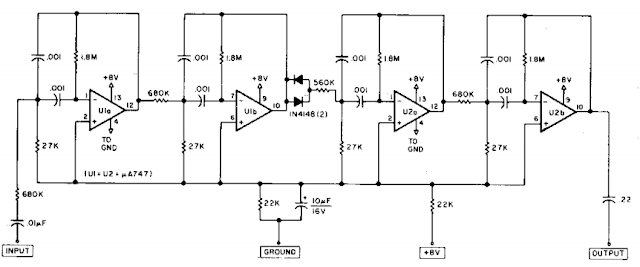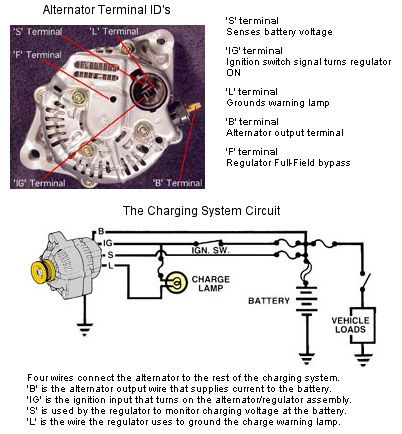Presettable times for train stops in stations are indispensable if you want to operate your model railway more or less realistically according to a timetable. This circuit shows how a 555 timer can be used with a relatively small timing capacitor to generate very long delay times as necessary by using a little trick (scarcely known among model railway electronic technicians): pulsed charging of the timing net-work. Such long delays can be used in hidden yards with through tracks, for instance. As the timer is designed for half-wave operation, it requires only a single lead to the transformer and one to the switching track or reed contact when used with a Märklin AC system (H0 or H1). The other lead can be connected to any desired grounding point for the common ground of the track and lighting circuits.
Circuit diagram :
Long-Delay Stop Switch Circuit Diagram
As seen from the outside, the timer acts as a monostable flip-flop. The output (pin 3) is low in the quiescent state. If a negative signal is applied to the trigger input (pin 2), the output goes high and C4 starts charging via R3 and R4. When the voltage on C4 reaches 2/3 of the supply voltage, it discharges via an internal transistor connected to pin 7 to 1/3 of the supply voltage and the output (pin 3) goes low. The two threshold values (1/3 and 2/3) are directly proportional to the supply voltage. The duration of the output signal is independent of the supply voltage: t= 1.1(R4 + R5) × C4
if the potentiometer is connected directly to the supply line (A and B joined). The maximum delay time that can be generated using the component values shown in the schematic diagram is 4.8 minutes. How-ever, it can be increased by a factor of approximately 10 if the timing network is charged using positive half-waves of the AC supply voltage (reduced to the 10–16-V level) instead of a constant DC voltage.
The positive half-waves of the AC voltage reach the timing network via D2, the transistor, and D3. Diode D3 prevents C4 from being discharged between the pulses. The total resistance of R4 and R5 should not be too high (no more than 10 MΩ if possible), since electrolytic capacitors (such as are needed for C4) have significant leakage currents. Incidentally, the leakage current of aluminium electrolytic capacitors can be consider-ably reduced by using a supply voltage well below the rated voltage. Capacitor C6 is intended to suppress noise. It forms a filter network in combination with an internal voltage-divider resistor.
If a vehicle happens to remain standing over the reed switch so the magnet holds the contacts constantly closed, the timer will automatically be retriggered when the preset delay times out. In this case the relay armature will not release and the locomotive will come to the ‘end of the line’ in violation of the timetable. This problem can be reliably eliminated using R6, R7 and C5. This trigger circuit ensures that only one trigger pulse is generated, regardless of how long the reed switch remains closed. RC network R8/C7 on the reset pin ensures that the timer behaves properly on switch-on (which is far from being something to be taken for granted with many versions of the 555 or 556 dual timer).
Reed switches have several special characteristics that must be kept in mind when fitting them. The contact blades, which are made from a ferromagnetic material, assume opposite magnetic polarities under the influence of a magnetic field and attract each other. Here the position and orientation of the magnet, the distance between the magnet and the reed switch, and the direction of motion of the magnet relative to the switch are important factors. The fragility of the glass hous-ing and the thermal stress from soldering (stay at least 3 mm away from the glass housing) require a heat sink to be used between the soldering point and the glass/metal seal. A suitable tweezers or flat-jawed pliers can be used for this pur-pose. If you need to bend the leads, use flat-jawed pliers to protect the glass/metal seal against mechanical stresses.
Matching magnets in various sizes are available from toy merchants and electronics mail-order firms. They should preferably be fitted underneath the loco-motive or carriage. However, the magnet can also be fitted on the side of a vehicle with a plastic body. In this case the reed switch can be hidden in a mast, bridge column or similar structure or placed in a tunnel, since the distance must be kept to less than around 10 mm, even with a strong magnet. If fitting the circuit still presents problems (especially with Märklin Z-gauge Mini-Club), one remedy is to generate the trigger using a unipolar digital Hall switch, such as the Siemens TLE4905L or Allegro UGN3120. To avoid coupled-in interference, the stop timer should be fitted relatively close to the Hall sensor (use screened cable if necessary). Pay attention to the polarity of the magnet when fitting it to the bottom of the vehicle. With both types of sensors, the South pole must point toward the front face of the Hall IC (the face with the type marking). The North pole is sometimes marked by a dab of paint. Generally speaking, the polarity must be determined experimentally.
Fitting the circuit is not a problem with Z-gauge and 1-gauge tracks, since the distance between the iron parts (rails) and the Hall switch is sufficiently large. In an HO system, some modifications must be made to the track bed of the Märklin metal track. Cut a suitably sized ‘window’ between one wheel rail and the centre rail in order to prevent secondary magnetic circuits from interfering with the operation of the sensor. Keep the distance between the magnet and the case of the Hall switch between 5 and 10 mm, depending on the strength of the magnet, to ensure reliable actuation.
Source by : Streampowers


















































